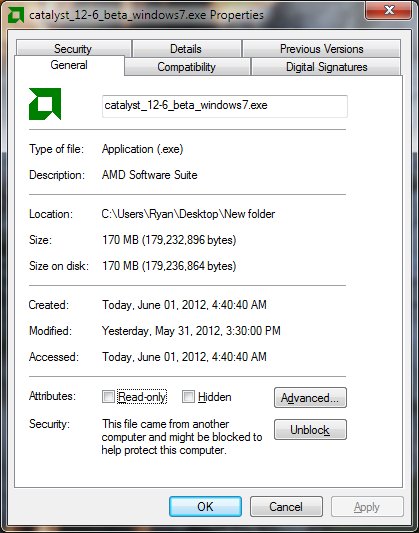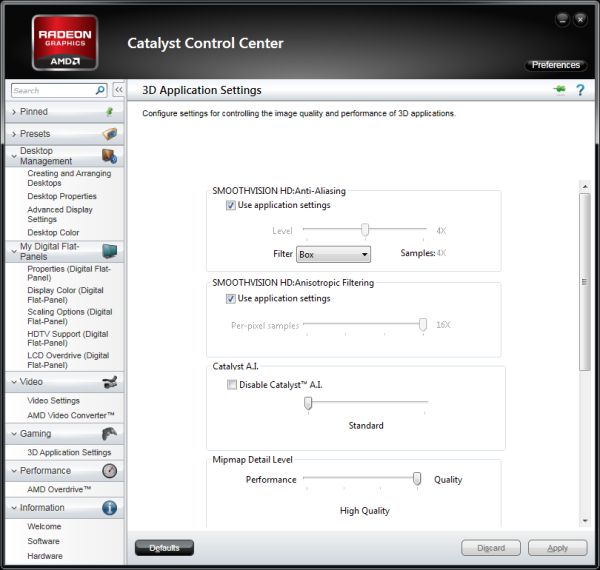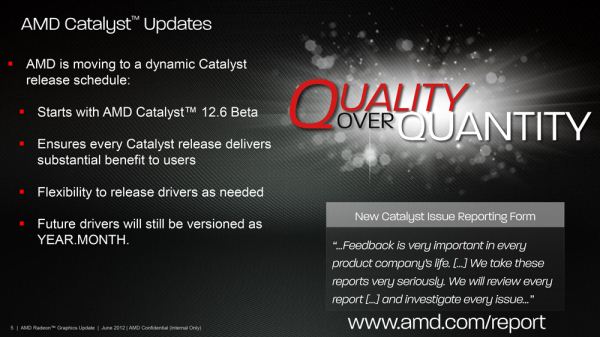AMD Discontinues Monthly Driver Updates, Releases Catalyst 12.6 Beta
by Ryan Smith on June 1, 2012 9:00 AM ESTThe last month or so has been one of transition for AMD’s Catalyst driver crew. Alongside the launch of AMD’s Trinity APU – complete with what’s only AMD’s 2nd VLIW4 GPU – AMD has also been hard at work on preparing their next Windows 8 drivers, and on the development side of things AMD also put plans into motion to move their DX10 GPU families to legacy status. Capping this off, AMD’s driver team is embarking on one more change, and for long-time AMD followers it’s going to be a doozy.
For the better part of a decade now AMD (née ATI) has released new WQHL-certified video drivers on a monthly basis. In principle this enables AMD to offer driver updates on a predictable schedule, and to spread out major driver changes over a few versions of the driver. In practice this is exactly how things have worked up until the last couple of years, which is why we’ve been fans of AMD’s driver update schedule for the longest time.

ATI Catalyst 3.8
With that said, that time has come to a close. AMD has announced that starting with Catalyst 12.6 AMD will be ceasing their monthly driver update schedule in favor of releasing drivers on a dynamic/as-needed basis, effectively taking up NVIDIA’s driver release schedule. Instead of 12 monthly WHQL releases plus a smattering of beta and hotfix drivers, AMD will have what we’d estimate to be around half as many WHQL releases alongside an unknown number of beta driver releases. It’s a significant change for AMD’s Catalyst crew and one we’re glad to see they’re making.
Why? As we briefly mentioned before, the benefits of AMD’s monthly driver release schedule were realized in practice for quite some time, but only up until the last couple of years. Starting around the release of the HD 5000 series though those benefits became harder to realize and less meaningful. The issue is at its basic level one of complexity – AMD’s drivers continue to grow in size and complexity, with the latest release weighing in at 170MB. Video drivers have effectively eclipsed Windows 95 in complexity and size in the last couple of years, which reflects the fact that these devices really have become processors, complete with all the intricacies of code compilation and scheduling, and basically in need of a mini-OS just to run them.

The result has been that AMD (and NVIDIA too) have both seen their driver development schedules become more drawn out. For AMD this has meant fewer major driver branches are released in any given year as it takes them longer to research, develop, and assemble the various optimizations and features that are added to their drivers. Consequently the need to release drivers on a monthly basis has led to some driver releases that bring few if any changes, as AMD has no new additions to that driver branch as they work on the next branch. In other words, AMD’s monthly commitment meant AMD had to release drivers whether they had something new or not.
Really this branch problem came to a head in the later part of last year with AMD’s disastrous October driver releases where they ended up with several different drivers being released in the same month; a regular Catalyst release, a BF3 release, and a Rage release that didn’t contain the BF3 improvements. Even without a fixed driver release schedule AMD will still have driver branches and the need to manage the development of multiple branches at once – that’s just the reality of this kind of software development – but it will free up resources that previously needed to be committed to the monthly driver, and in all likelihood it will make project management easier for AMD by making it push major development along a single branch (avoiding a BF3/Rage situation).
As it stands AMD has already missed one monthly driver drop with Catalyst 12.2 (the first regular driver in the 7000 series branch), and AMD will have missed another monthly driver drop with 12.5, which missed its May deadline. It’s clear that thanks in large part to these jumps in complexity and development time that monthly driver releases have become unsustainable for AMD, and behind the scenes we’ve been prodding AMD to move to a dynamic schedule for that exact reason. This makes us all the more glad to see that rather than foolishly try to keep up with this schedule that they’re backing off from trying to release so many drivers.

Modern Catalyst Control Center
However it would be remiss of us to not point out a second, more practical reason for this change too: a reduced necessity. Prior to 2010, full Catalyst driver releases were the only way for AMD to release any kind of driver change. That changed with Catalyst 10.2, which saw the introduction of Catalyst Application Profiles (CAPs). CAPs were primarily created to ease the distribution of new game profiles for Crossfire, but in some cases more general single-GPU problems can be fixed in those profiles. By manipulating the various compatibility settings in their profiles AMD can fix some issues without requiring a driver update, such as CAP 12.4-2 which improved the performance of Max Payne 3 for both single video cards and Crossfire configurations. Larger issues still require a full driver release of course, but compared to years before the advent of CAPs there’s definitely a reduced need thanks to the separation of driver and profile.
Going Forward
As we stated earlier, AMD will be moving to a dynamic/as-needed schedule for driver releases. It’s their hope – as it is ours – that they’ll be able to further improve on the quality and meaningfulness of Catalyst driver releases. Certainly this will cut out the release of near-useless Catalyst drivers, whereas quality as always remains to be judged. Realistically AMD’s most immediate goal should be to do a better job of getting drivers out for major new games as necessary, as that’s something they’ve particularly struggled with and is the thing the new schedule should help the most with by freeing up resources.
To that end the Catalyst 12.6 driver, released in beta form today, will be the first such driver release. We haven’t had a chance to evaluate these drivers in depth yet, but they are from AMD’s latest driver branch and should contain the typical assortment of performance improvements and bug fixes that we’ve come to expect from a major Catalyst release.
Also, it should be noted that while AMD is changing their release schedule their naming schedule is not changing. Catalyst drivers will still be named by [Year].[Month], which unfortunately means there are going to be holes in AMD’s numbering scheme. A month without a driver will simply be empty, so they could go from 12.6 to 12.8, for example. Importantly for non-technical users however this means that they maintain the date in the driver number, making it easy to tell whether a driver is recent or not.
On that note, the one thing AMD hasn’t changed so far but bears mentioning as something we’d like to see changed is AMD’s website. It has always been difficult to find AMD’s beta drivers from inside their website, a problem that is only going to become worse with the change in the release schedule. AMD needs to use this opportunity to change their site so that beta drivers are as easy to find as WHQL drivers, something that quite frankly NVIDIA has done a solid job of.
Finally, alongside the change to their driver release schedule AMD is also instituting a new driver report form to replace the older Catalyst Crew Feedback Form, which is being called the AMD Issue Report Form. The goal is the same, but AMD is moving to this new form in an attempt to gather better feedback from users than what the old form collected. If nothing else, we hope that AMD does a better job of keeping the form visible, as there seems to have been a lot of AMD users that simply never knew about the Catalyst Crew form.
Addendum: We've been informed by AMD that with the release of the Catalyst 12.6 betas, Catalyst 12.5 has been canceled entirely. 12.6 is what 12.5 would have been, and this has special significance for AMD's DX10 generation GPUs. 12.5 was supposed to be the last monthly Catalyst release that supported those GPUs but Catalyst 12.6 beta doesn't support them. So it's not clear when DX10 GPU owners will see a new driver; if this is the start of AMD's "quarterly" update cycle, then it may be a few months, making 12.4 the final driver for the time being.











77 Comments
View All Comments
JarredWalton - Friday, June 1, 2012 - link
You can also get information on the driver build date from AMD's drivers. For example, I have a desktop running Catalyst 12.1 drivers that reports a driver package of "8.93-111205a-132104C-ATI". The important part is the second set of numbers. 111205a is a package build from 2011, December 05 -- so basically it had a month of testing before officially releasing in Jan 2012.For desktops running reference drivers, this isn't all that useful, but on laptops it certainly is. A Sony VAIO SE as another example doesn't report a Catalyst build but the driver package is "8.862.4.4-111222a-134541C-Sony". So that build is from 2011, December 22. At least, that's my understanding of the numbers. :-)
jeremyshaw - Friday, June 1, 2012 - link
Yeah, even with the later updates (May 2012 got one for the S lineup), it's mostly just Sony product related bugfixes (i.e, the 3D screen filter addon), and the build date remains the same for the core AMD driver.dagamer34 - Friday, June 1, 2012 - link
Video card drivers are like hard drives, everyone claims to have been burned by one manufacturer and moved to someone else.bryanb - Friday, June 1, 2012 - link
The actual driver is only a few megabytes. Over 150+ MB of the package is the extremely bloated .NET based Catalyst Control Center.Ryan Smith - Friday, June 1, 2012 - link
Basic display drivers; 104MBOpenCL Drivers: 25MB
Various video encode/decode packages: 10MB
Visual C++ Redistributable: 18MB
CCC: 62MB
Penti - Sunday, June 3, 2012 - link
The CCC size is crazy. That the actual drivers is pretty complex is a given now though. Lots of stuff there, multiple architectures and whatever. D3D9-11, DirectCompute, OpenGL, DXVA, gamefixes and more. I believe the OGL driver in AMD's drivers is about 18MB itself. Mobile devices are lucky to have less legacy to support.nubie - Friday, June 1, 2012 - link
The drivers don't need to be this big you know.I don't want bundled physics and compute, not to mention the god-awful mess that is the driver control panel and 3 or 4!!! background apps running full time and crashing.
What happened to drivers that just freaking worked? Also if you can measure the time it takes to change a setting in the control panel with a sand timer there is something horribly wrong.
Not to mention that I can't even remove CCC because I switched back to the Intel HD, and then an nVidia card, but still get a damn failure message every time I had to use Regedit to remove.
Still don't understand how 30mb of driver and 140mb of crapware is necessary?
ltcommanderdata - Friday, June 1, 2012 - link
Since they've missed the Cat 12.5 release and Cat 12.5 was supposed to be the final monthly driver for the HD2000/3000/4000 series and the basis for future legacy drivers what does this mean? Is Cat 12.5 still coming?Ryan Smith - Friday, June 1, 2012 - link
I just got confirmation from AMD that 12.5 has been canceled entirely. It appears that 12.6 is what 12.5 would have been, but without support for legacy GPUs.At this point I do not know what this means for legacy users. It seems unlikely that AMD will include support for legacy users with the WHQL version of 12.6. In which case it may be a few months until AMD releases an irregular Catalyst legacy driver.
Wreckage - Friday, June 1, 2012 - link
I've been saying for a long time that their marketing driven driver release schedule has been detrimental to their quality.Release drivers when they are done, not when your marketing dept says so.